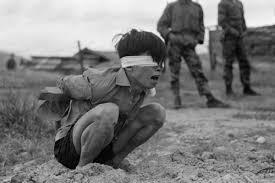
What is torture?
The UN Convention against Torture and Other Cruel, Inhuman or Degrading Treatment or Punishment explains that,
"the term ‘torture’ means any act by which severe pain or suffering, whether physical or mental, is intentionally inflicted on a person for such purposes as obtaining from him or a third person information or a confession, punishing him for an act he or a third person has committed or is suspected of having committed, or intimidating or coercing him or a third person, or for any reason based on discrimination of any kind, when such pain or suffering is inflicted by or at the instigation of or with the consent or acquiescence of a public official or other person acting in an official capacity."
Article 37(a) of the Convention on the Rights of the Child (CRC) provides that “No child shall be subjected to torture or other cruel, inhuman or degrading treatment or punishment.” Article 19requires States to “take all appropriate legislative, administrative, social and educational measures to protect the child from all forms of physical or mental violence, injury or abuse, neglect or negligent treatment, maltreatment or exploitation, including sexual abuse, while in the care of parent(s), legal guardian(s) or any other person who has the care of the child.”
The prohibition of torture is an absolute right – this means that it cannot be derogated from, or excused for, any reason.
When and why are children tortured?
UNICEF says that the torture of children “occurs in different contexts, including police operations against children seen as a threat to public order or safety; children confined in prisons or detention facilities; and children seen as linked to subversive groups, including the children of militants” (O’Donnell and Liwski 2010: 28).
The UN Study on Violence Against Children (UNVC, 2006: 175) notes, in particular, that children in institutional care in many countries are subject to violence from staff and others responsible for their wellbeing. “This can includetorture, beatings, isolation, restraints, rape, harassment, and humiliation,” says the report. In Nepal, following interviews in prisons, 58.6 per cent of children and young people reported torture with methods including electric shocks, beatings with hard objects, beatings with their hands tied, and beatings while blindfolded.
Police forces may also use torture to extract information and confessions. According to the UN Study, “In Pakistan, the National Commission for Child Welfare and Development found that of juvenile detainees, 68 per cent of respondents reported having been forced to admit their guilt,” while in Papua New Guinea, “children have been burned, cut with scissors, whipped while naked, and humiliated during interrogations by police in order to get them to confess to a crime” (UNVC, 2006: 197). The Council of Europe’s Committee for the Prevention of Torture says young people are kept in the same cells as adults in at least three Council of Europe countries, putting them at risk of threatening behaviour, blackmail, or even rape by older prisoners.
What is the difference between torture and child abuse?
According to O’Donnell and Liwski (2010), torture is distinguished from child abuse for the following reasons:
- torture is committed by an agent of the state or someone acting with the encouragement or acquiescence of the state;
- torture is committed for the purpose of obtaining information or a confession; to intimidate, coerce or punish the immediate victim or a third person; or as part of discrimination;
- torture must cause severe pain or suffering.
International law is not clear on the difference between torture, cruel, inhuman and degrading treatment or punishment. The Committee against Torture has stated that, while “In practice, the definitional threshold between ill-treatment and tortureis often not clear..., [i]n comparison to torture, ill-treatment differs in the severity of pain and suffering.” According to UNICEF,
"In international human rights law the concept of punishment is generally understood to refer to a formal sanction imposed by a court or administrative authority. The term corporal punishment has broader usage, however, including punishment imposed informally within the family, schools, residential facilities for children and similar settings. [This] indicates that all physical punishment intended to cause pain or discomfort is degrading, and hence incompatible with the CRC" (O’Donnell and Liwski, 2010: 16).
According to the Committee on the Rights of the Child’s 2006 General Commenton “The right of the child to protection from corporal punishment and other cruel or degrading forms of punishment”, non-physical punishment that “belittles, humiliates, denigrates, scapegoats, threatens, scares or ridicules the child” is cruel and degrading and incompatible with the CRC.
What can be done about torture?
Impunity, and lack of proper investigation into allegations of torture, promotes its use. However, the best interests of the child, in any justice proceedings, must be the primary concern. Therefore, the obligation to bring torturers to justice in order to prevent impunity must be reconciled with the right of child victims to psychological recovery.
The United Nations Guidelines on Justice in Matters involving Child Victims and Witnesses of Crimes can help reconcile these concerns. They provide that victims should be treated in a caring and sensitive manner that takes into account their personal situation and needs, and respects their physical, mental and moral integrity; that interviews and examinations should be conducted by trained professionals; and that all interactions should be conducted in a child-sensitive manner in a suitable environment (O’Donnell and Liwski 2010).
The Committee on the Rights of the Child, in its Concluding Observations to States, points out gaps in national legislation, and encourages governments to ratify the UN Convention against Torture and Other Cruel, Inhuman or Degrading Treatment or Punishment (CAT) where they have failed to do so. For example, in 2003, it urged Pakistan to ratify the CAT, in 2005 it noted shortcomings in legislation in Costa Rica, and in 2009 it urged the government of the Democratic Republic of Congo to make sure the definition of torture in national legislation matched the definition as defined in CAT.
Source: Crin
 FR
FR EN
EN AR
AR








